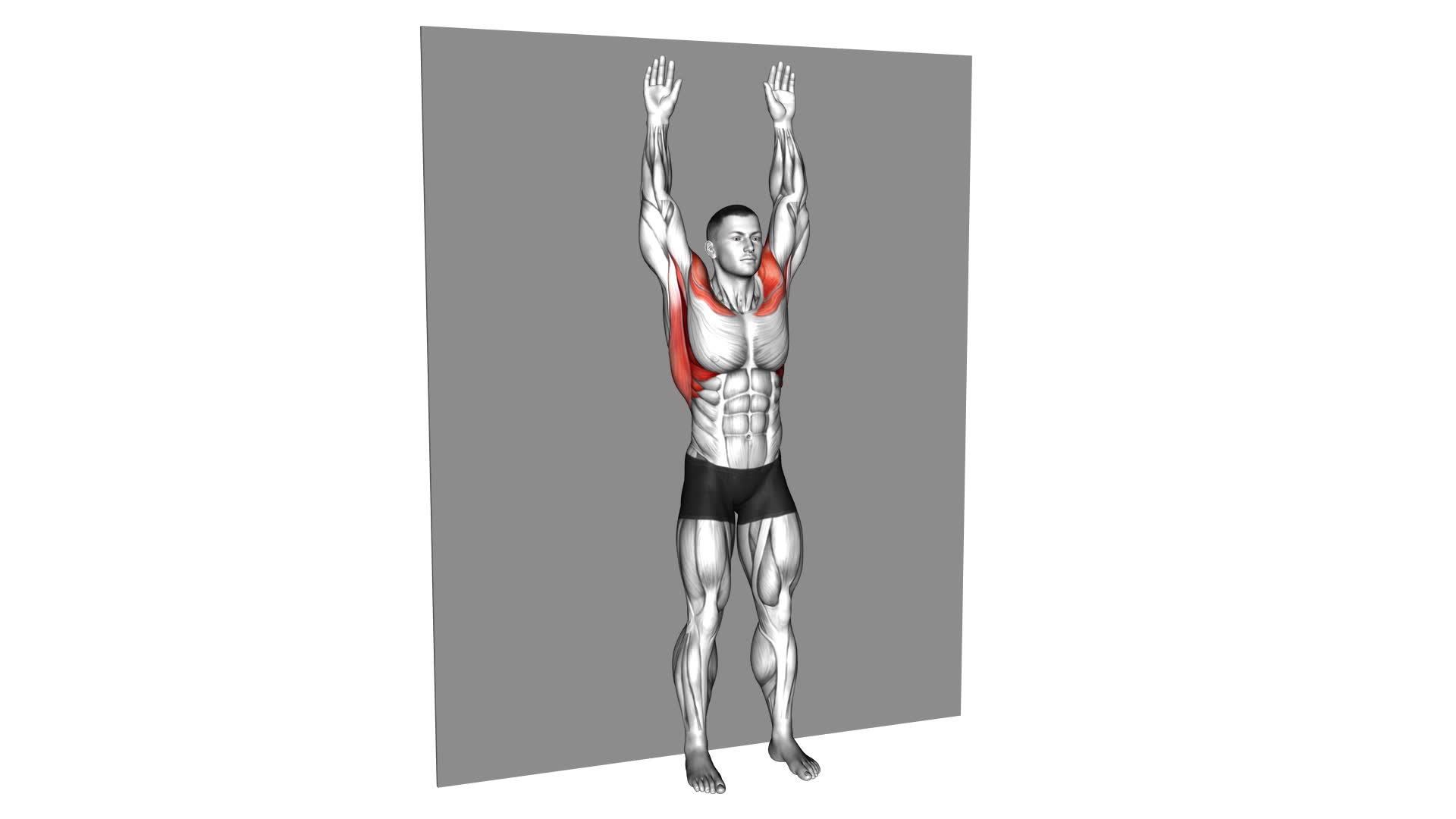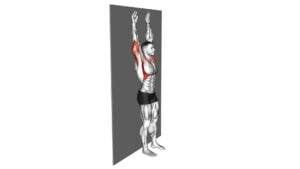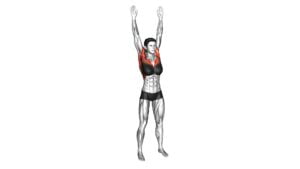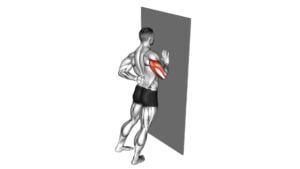Bodyweight Standing Around World Wall Supported – Video Exercise Guide & Tips

Are you looking for an effective full-body exercise that you can do anywhere? Look no further than the Bodyweight Standing Around World Wall Supported.
Watch This Exercise Video
This exercise targets your arms, shoulders, core, and legs while also improving your balance and stability.
In this video exercise guide, you'll learn the proper form and technique, as well as variations and progressions for all fitness levels.
Avoid common mistakes and get tips for incorporating this exercise into your workout routine.
Get ready to amp up your fitness game!
Key Takeaways
- Bodyweight standing around the world wall supported targets multiple muscle groups simultaneously.
- Proper form and technique are crucial to maximize the effectiveness of the exercise.
- There are various variations and progressions available for all fitness levels.
- Avoiding common mistakes and incorporating the exercise into your workout routine can lead to improved strength, stability, and overall fitness.
Benefits of Bodyweight Standing Around World Wall Supported
One major benefit of Bodyweight Standing Around World Wall Supported is that it targets multiple muscle groups simultaneously. This exercise is highly advantageous because it engages various muscles, resulting in efficient and effective workouts. By utilizing your bodyweight and the support of a wall, you can work your chest, shoulders, triceps, core, and legs all at once. This means that you can maximize your workout time and see quicker results.
Engaging multiple muscle groups simultaneously not only saves time but also increases the intensity of your workout. As you perform the Bodyweight Standing Around World Wall Supported exercise, you're challenging your muscles to work together, which leads to improved strength and coordination. Additionally, this exercise helps to improve your overall stability and balance, as you're required to maintain a strong and stable position throughout the movement.
To perform this exercise correctly, it's important to maintain proper form and technique. By following the correct form, you can ensure that you're targeting the intended muscle groups and minimizing the risk of injury. So, let's now dive into the proper form and technique for the Bodyweight Standing Around World Wall Supported exercise.
Proper Form and Technique for the Exercise
To perform the Bodyweight Standing Around World Wall Supported exercise correctly, maintain proper form and technique. This exercise involves standing facing a wall, with your feet shoulder-width apart and about a foot away from the wall. Place your hands on the wall at shoulder height and lean your body forward slightly, engaging your core muscles.
A common mistake to avoid is rounding your back or hunching your shoulders. Keep your spine straight and your shoulders down and relaxed throughout the exercise. It's important to maintain a neutral position to prevent unnecessary strain on your back and neck.
Another common mistake is allowing your knees to collapse inward. Make sure to keep your knees aligned with your toes and avoid any inward or outward movement. This will help to protect your knees and maintain proper alignment.
If you find this exercise challenging, you can modify it by standing closer to the wall or using a stability ball between your back and the wall for support. This will provide additional stability and make the exercise more accessible.
Remember to breathe deeply and engage your core muscles throughout the exercise. By maintaining proper form and technique, you can safely and effectively perform the Bodyweight Standing Around World Wall Supported exercise.
Variations and Progressions for All Fitness Levels
Try different variations and progressions of the Bodyweight Standing Around World Wall Supported exercise to challenge yourself and cater to your fitness level. Here are some modifications and challenges you can incorporate into your routine:
- Single-leg variation: Lift one leg off the ground while performing the exercise to increase the difficulty and engage your core and leg muscles even more.
- Weighted variation: Hold a dumbbell or kettlebell in your hands while circling around the world to add resistance and further strengthen your upper body.
- Tempo variation: Slow down the movement, taking a few seconds to complete each circle, to increase time under tension and enhance muscle endurance.
- One-arm variation: Perform the exercise with only one arm, alternating between arms with each repetition. This variation will challenge your stability and balance while targeting one arm at a time.
By incorporating these modifications and challenges, you can continuously progress and improve your strength, stability, and overall fitness.
Now, let's move on to the next section and learn about the common mistakes to avoid during the exercise to ensure you perform it safely and effectively.
Common Mistakes to Avoid During the Exercise
To ensure that you perform the Bodyweight Standing Around World Wall Supported exercise safely and effectively, it's important to be aware of common mistakes to avoid. By understanding these mistakes, you can modify your technique and get the most out of this exercise.
One common mistake to avoid is using excessive momentum. It's important to maintain control throughout the movement and not rely on swinging your body to complete the rotation. This can be achieved by engaging your core and focusing on a slow and controlled movement.
Another mistake to watch out for is poor posture. It's crucial to maintain proper alignment throughout the exercise. Keep your spine neutral, shoulders back, and chest lifted. Avoid rounding your shoulders or hunching over, as this can lead to strain and reduce the effectiveness of the exercise.
Lastly, be mindful of your grip. Gripping the wall too tightly can cause unnecessary tension in the upper body. Instead, maintain a firm but relaxed grip to avoid fatigue and allow for fluid movement.
Tips for Incorporating the Bodyweight Standing Around World Wall Supported Into Your Workout Routine
To get the most out of incorporating the Bodyweight Standing Around World Wall Supported exercise into your workout routine, consider using a stable wall and adjusting the variations to challenge yourself. Here are some tips to help you maximize the benefits of this exercise:
- Modifications and adaptations for individuals with limited mobility:
- If you have limited mobility or balance issues, you can start by performing the exercise with a chair or a stability ball for support.
- Gradually decrease the level of support as you build strength and confidence.
- You can also perform the exercise with a resistance band around your thighs to provide additional stability.
- How to increase the intensity of the bodyweight standing around world wall supported exercise:
- Once you have mastered the basic version of the exercise, you can increase the intensity by adding weights. Hold a dumbbell or kettlebell in both hands while performing the movement.
- You can also try performing the exercise on an unstable surface, such as a BOSU ball or a foam pad, to challenge your core stability.
- Increase the number of repetitions or the duration of each repetition to make the exercise more challenging.
- You can also try performing the exercise in a single-leg stance to further engage your core and improve your balance.
Frequently Asked Questions
Can I Do the Bodyweight Standing Around World Wall Supported Exercise if I Have Limited Upper Body Strength?
Yes, you can still do the bodyweight standing around world wall supported exercise even if you have limited upper body strength. It's a great way to improve your upper body strength over time.
If you're a beginner, you can modify the exercise by starting with shorter holds or using a lower wall height. As you gradually build strength, you can increase the duration of the holds and work your way up to a higher wall height.
How Long Should I Hold Each Position During the Exercise?
When doing the bodyweight standing around world wall supported exercise, it's important to know how long to hold each position. The duration of each position will vary depending on your fitness level and goals.
If you have limited upper body strength, you may need to start with shorter holds and gradually increase the time as you get stronger.
It's always best to listen to your body and not push yourself too hard.
Can This Exercise Help Improve My Balance and Stability?
Improving your balance and stability is the main benefit of this exercise. By engaging your core muscles and challenging your body to maintain a stable position, you can enhance your balance and stability over time.
The wall support provides additional support and stability, allowing you to focus on your form and technique.
Consistency and proper execution are key to seeing improvements in your balance and stability.
Is It Necessary to Warm up Before Performing the Bodyweight Standing Around World Wall Supported?
Before performing the bodyweight standing around world wall supported exercise, it's necessary to warm up.
Warming up before any exercise helps increase blood flow, flexibility, and prepares your muscles for the workout. It reduces the risk of injury and improves overall performance.
If you don't have time for a full warm-up, you can do alternatives like light cardio exercises or dynamic stretches.
Can I Perform This Exercise if I Have a Shoulder Injury?
If you have a shoulder injury, it's important to modify the Bodyweight Standing Around World Wall Supported exercise.
You can try alternative exercises that don't put strain on your upper body, such as leg exercises or core workouts.
It's crucial to consult with a healthcare professional or a physical therapist to determine which exercises are safe for your condition.
Remember to prioritize your shoulder's recovery and avoid any movements that may worsen your injury.
Conclusion
Incorporating the bodyweight standing around world wall supported exercise into your workout routine can offer numerous benefits. With proper form and technique, you can target multiple muscle groups, improve balance and stability, and enhance overall strength.
By avoiding common mistakes and progressing at your own fitness level, you can maximize the effectiveness of this exercise. Add variety by exploring different variations and enjoy the convenience of a wall support.
Start incorporating this exercise into your routine for a well-rounded workout.

Author
Years ago, the spark of my life’s passion ignited in my mind the moment I stepped into the local gym for the first time. The inaugural bead of perspiration, the initial endeavor, the very first surge of endorphins, and a sense of pride that washed over me post-workout marked the beginning of my deep-seated interest in strength sports, fitness, and sports nutrition. This very curiosity blossomed rapidly into a profound fascination, propelling me to earn a Master’s degree in Physical Education from the Academy of Physical Education in Krakow, followed by a Sports Manager diploma from the Jagiellonian University. My journey of growth led me to gain more specialized qualifications, such as being a certified personal trainer with a focus on sports dietetics, a lifeguard, and an instructor for wellness and corrective gymnastics. Theoretical knowledge paired seamlessly with practical experience, reinforcing my belief that the transformation of individuals under my guidance was also a reflection of my personal growth. This belief holds true even today. Each day, I strive to push the boundaries and explore new realms. These realms gently elevate me to greater heights. The unique combination of passion for my field and the continuous quest for growth fuels my drive to break new ground.







